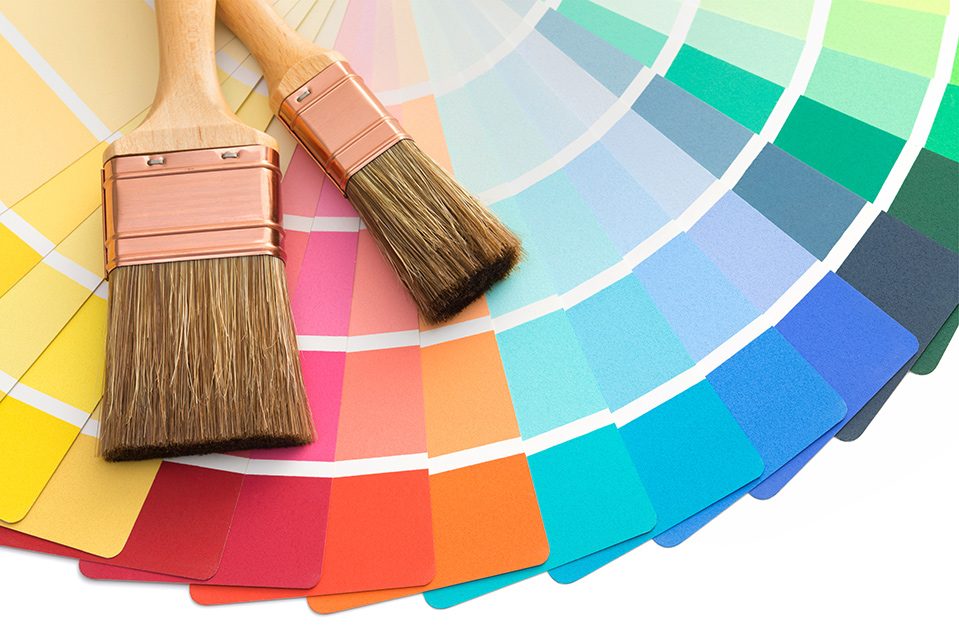
Colors are everywhere, and their various shades and hues bring life and interest into our world. They also do this for a home. Scientific studies have even shown that colors can affect our moods and behaviors. No wonder it’s exciting to pick up that paint brush and revamp your walls. It’s an opportunity to put your personal stamp on your space.
Exterior paint provides the first impression for your overall home, but interior colors are the foundation for the design, style, and feel of your space. So it is important to choose the right colors for your home — ones that will make you a trendsetter. Creating the perfect color design doesn’t need to be difficult. Follow these 8 tips to create a trendsetting design for the interior and exterior paint of your home.
Determine Your Design Aesthetic
It’s hard to know where to begin when choosing the correct colors for your home. But the perfect starting point is your design aesthetic. Whether you like modern, rustic, coastal, retro, or classic styles, there is a color palette to match.
Rustic looks will lend to more natural and dark colors, such as browns and beiges, while a coastal design will be the exact opposite, playing with light blues, greys, and whites. Modern styles will be simple and neutral with lots of black and white, while retro can play with bright colors like red and yellow. With the almost infinite color options, your design aesthetic will point you in a starting direction and will help ensure your furniture and accents will match your home’s exterior and interior paint choices.
Pay Attention to Your Home’s History
Stay true to your home. The historical era and features of your home’s design are a great place to seek color inspiration. While trends come and go, the originality of your home will not, so playing to that historical integrity will never go out of style. Craftsman style homes are well known for inviting, warm tones, while Victorian homes are known for bright colors and interesting accents.
But don’t be intimidated to put your personal stamp on the overall color pallet. While historical value is a great springboard for color, use it to keep your selection on track while tailoring the perfect paint selection for your home.
Pick a Coordinating Trim Color
Once you have chosen a primary paint color to accentuate the design of your home, you will also want to choose a complementing and contrasting trim color. This goes for both your home’s exterior and interior. While a monochromatic look can work for certain spaces, it typically leaves a home feeling bland and dated. This is where a contrasting trim comes into play. On the exterior, this paint can be used to enhance design features like trim, columns, eases, and window panes. While in the interior, accent colors can be used for molding, trim, doors, and windows.
Focus on an Accent Color
Too many colors can make a home feel chaotic. But the pop of a fun accent color can tie the whole look together and give personality to a room. Many designers suggest choosing colors in threes. Once you have your base and trim colors selected, the accent color can round out the trio.
Choose to add your accent to places you want to draw the eye. On the exterior of a home, a front door is a great place to add a fun accent color. In the interior, this color can be used on an accent wall, doorways, cabinets, and anywhere you want to add visual interest. Accent colors can be loud and bold, but they can also be a contrasting neutral shade, so follow your taste.
Let Design Elements Inspire You
Your color inspiration does not have to come from the outside world or just an idea. A piece of art, your favorite rug, or a beloved furniture item can be the inspiration that brings out the paint selection. To round out your overall space and the design, choose a color from items that you know will style your home, both on the interior and exterior.
Keep Your Tones Consistent
Picking a color palette is not merely picking colors you like and hoping they will work well together. It is the underlying tones that make a palette consistent and beautiful. You can choose from warm, neutral, or cool undertones, but once you have a paint selected keep your accent paint colors consistent in undertones.
Utilize Samples
Samples are a great way to analyze the feel of colors in your home without having to commit to a paint choice. As mentioned before, you want to keep the undertones in your color palette consistent. This means assessing your color options with other items in your home such as flooring, countertops, tile, and more.
For the exterior, items like landscaping, roofing, patio furniture, deck colors, and even location can help provide insight into the perfect shades your home needs.
Get Professional Advice
Design professionals know exactly how to create the perfect color pallet that matches your home’s surroundings and your personal design aesthetic. So there is no shame in seeking professional help for your paint selection. And even if you have an idea of what you want, remember that two heads are better than one. Getting professional advice will really keep the entirety of your home from room to room and to the exterior in a cohesive flow.
Make Your Home the Talk of Your Neighborhood
A beautiful exterior is only a phone call away. Schedule a consultation with our Lifetime Exteriors team and have a personal color consultant assist you in selecting the perfect exterior paint for your home free of charge! Our job is to make your exterior painting makeover a stress-free process and to make your home exterior last. Get a paint estimate with Lifetime Exteriors today by calling (503) 719-6644.

